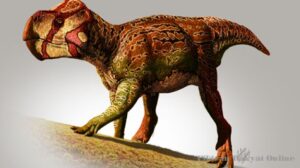Scientific Imagining

Author(s): Deb Spatafore
Subject: Life Science
Grade Level(s): Grade 3
Big Idea(s): Students will learn that Paleo Artists use scientific information to communicate visual images of dinosaurs, even though we have no direct record of what they looked like. Students will create their own drawing of a Hadrosaur based on a Hadrosaur skeleton
What you need: * 9″ x 12″ white construction paper
* pencil/eraser
* coloring materials (watercolors, colored pencils, and
* copy of the Hadrosaur skeleton
Setting: In the Classroom
Time Needed: 1-2 days
Summary:
Students will learn about Paleo Art and then students will be the given the opportunity to be a paleo artist. Students will decide what they believe a Hadrosaur looks like based off of the scientific facts given.
Learning Goals / Objectives:
Students will learn that Paleo Artists use scientific information to communicate visual images of dinosaurs, even though we have no direct record of what they looked like. Students will create their own drawing of a Hadrosaur based on a Hadrosaur skeleton.
Background
Julius T. Costonyi won the Lanzendorf Paleo Art Prize 2010 and 2012.
The John J. Lanzendorf Paleo Art Prize was created to recognize outstanding achievement in paleontological scientific illustration and naturalistic art. These are the only art awards presented by the scientific community that specifically recognize accomplishments in paleontological visualization. PaleoArt is broadly defined as the scientific or naturalistic rendering of paleontological subject matter pertaining to vertebrate fossils. PaleoArt is one of the most important vehicles for communicating discoveries and data among paleontologists, and is critical to promulgating Vertebrate Paleontology across disciplines and to lay audiences.
Setup:
Gather materials and provide students with 9″ x 12″ white construction paper, pencil/eraser, and coloring materials… watercolors (sets, brush, water, rags), or colored pencils, or tempera paint (brushes, rags, water). Also provide students with a copy of the Hadrosaur skeleton (attached).
Anticipatory Set:
Discuss and Learn About Paleo Art
Provide students with the following information:
1. Paleo Artisits are artists who create illustrations and 3-dimensional models of dinosaurs and their environments. These are created for textbooks, movies, and museums.
2. Paleo Artists are often trained as scientists.
3. Paleo Artists cannot work from photographs of dinosaurs, or even descriptions from people who saw them… because neither exist.
4. Paleo Artists use the latest scientific information about dinosaurs to create their illustrations (for example, many Paleo Artists are adding feathers to a certain class of dinosaurs, because new scientific evidence shows that many of them were prehistoric bird-like creatures.) They also look at fossils and skeletons for clues as to what the dinosaur looked like.
5. Our ideas of what dinosaurs look like, come from the visualizations of Paleo Artists.
Instructions / Activities:
Discuss the Anchor Artwork
Show students the anchor artwork and discuss, perhaps using the following questions.
1. What can we tell about this dinosaur by looking at the illustration (it is a herbivore, it walked on four legs, each foot has three toes, it is red, green and brown and has bumpy skin).
2. How do you think the artist knew what to draw? (see information in 4. Anticipatory set)
3. Where do you see the light and dark colors in this illustration?
4. What do the light and dark colors help us to see? (texture and musculature of the dinosaur)
Learn about Tints and Shades
a. Explain to students that TINTS are LIGHTER colors. They are created by using art media in special ways…
* with COLORED PENCILS, tints are created by coloring very lightly, without much pressure.
* with WATERCOLOR, tints are created by adding lots of water to the paint, or by blotting away some paint.
* with TEMPERA PAINT, tints are created by adding whited to a color.
b. Explain to students that SHADES are DARKER colors. They are created by using art media in special ways, too.
* with COLORED PENCILS, shades are created by layering darker colors (like black, brown, or blue) over the original color.
* with WATERCOLOR, tints are created by mixing darker colors with the original color.
* with TEMPERA PAINT, tints are created by adding black to a color.
Create the Artwork
1. Provide students with 9″ x 12″ white construction paper, pencil/eraser, and coloring materials… watercolors (sets, brush, water, rags), or colored pencils, or tempera paint (brushes, rags, water). Also provide students with a copy of the Hadrosaur skeleton (attached).
2. Have students cover the back of the Hadrosaur skeleton copy with graphite or dark chalk. Demonstrate how to trace around the outside of the skeleton, to arrive at the basic shape of the dinosaur.
3. Have students read facts about the Hadrosaur (together as a class, or in small groups) and discuss how the information might be helpful to the drawing. Note: The funnel shape crest on the Hadrosaur forehead may need some further explanation, but try to refrain from drawing it for students.
4. Have students add details to their drawing.
5. Have students add color to their drawings using tints and shades. (think of your drawing as a three-dimensional model of a dinosaur. What parts sink inward? around the eyes… the top of the hip, the inside and outside of legs and arms. These should be colored as a shade. What parts stick out or protrude? [the center of the body, legs and arms… the forehead] These should be colored be colored as a tint.)
Assessment:
Teacher Discretion
Wrap-up / Closure:
Gather illustrations together and discuss.
(What science facts about the Hadrosaur are included in your illustartion? What illustration shows good use of tints and shades? Why?)
If you want, you can show other Paleo Artist ideas of what a Hadrosaur looked like.
Follow-Up
Watch a great, short movie about Hadrosaur Honking, on the website below. Note: This site has an advertisement lead in, with no option to skip. Set up viewing after ad has played.
http://dsc.discovery.com/video-topics/other/dinosaur-videos/prehistoric-los-angeles-hadrosaur-honking.htm
Attachments:
Tags: Grade 3
Categories: Life Science

